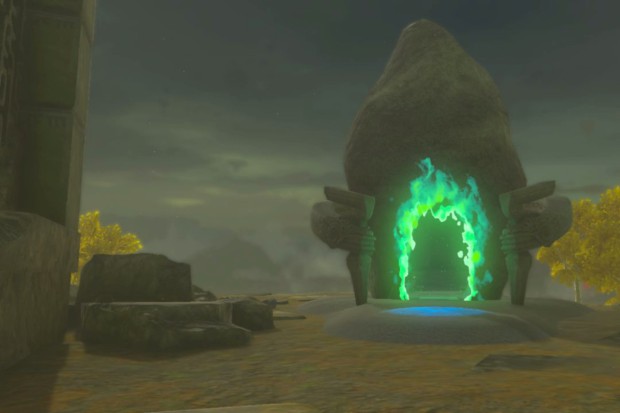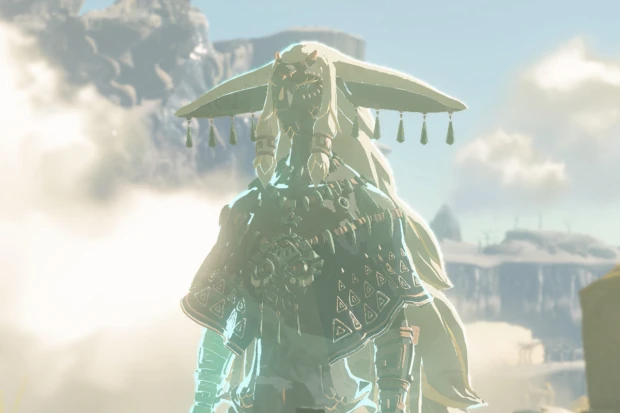by Jed Pressgrove
The shift from dungeons to shrines* in the The Legend of Zelda series smacks of creative convenience. Shrines give the developers freedom to throw in whatever puzzles or enemy encounters they want without overarching context. Everything in a dungeon, ideally, works together like the instrumentalists in an orchestra. However small the dungeon elements might be, they create something bigger than their sum. A dungeon needs vision. A shrine doesn’t. And so the shrines in Breath of the Wild seem less like an art and more like the scattered ideas of game design students.
Immediately following the transition from the Great Sky Island to the ballyhooed open world, Tears of the Kingdom plays into the worst disposable tendencies of the shrine paradigm. What does it say when a 2023 Zelda title — a good six years removed from its predecessor’s experimentation — dedicates an entire shrine to a contrived lesson on item throwing? It reeks of inefficiency, as you would hope the lengthy introductory tutorial would fully cover something as rudimentary as item throwing. And it doesn’t suggest adventure, neither in terms of being rewarded for wandering about, nor in terms of being stimulated by curiosity or surprise. Maybe the point is to celebrate the player’s ability to follow basic instructions. Upon completion of the task (i.e., dismantling a stupid robot standing on higher ground in the middle of a room), a voice remarks, “You have proven your mastery,” which is akin to giving someone a college degree because they can zip up their pants.
The second shrine I visited proved just as perfunctory. Its hurdles involved rehashed Ultrahand lessons from the Great Sky Island — fusing logs together for Link to walk across or climb, and crafting a raft with fans to travel on water. These mind-numbingly vapid challenges, like the item-throwing routine, say more about the smarmy design philosophy of modern-day Nintendo than they do about the setting of Tears of the Kingdom. As in Breath of the Wild, Nintendo appears frightened of letting players off the leash at the beginning. These games are as unconfident and repetitious as they are grandiose. The initial shrines in Tears of the Kingdom point to the company’s conservatism as much as the open world hearkens back to the conviction of the original Zelda on the NES.
Then something magical happened. As I scaled a mountain to draw closer to a third shrine, I found myself in the clutches of the morbidly fascinating Gloom Hands. These hands reach out of puddles that spread like a virus. It’s like a child’s nightmare, this idea of strange hands touching you, pulling you, kidnapping you to hell to do God knows what. I was able to shake loose of the hands and arrive to the Morok Shrine, but the undying threat of the hands foreshadowed an hour-plus purgatorial struggle I would have in the glorified mini dungeon.
— – <<—
Let me back up. When you leave the Great Sky Island, you have the choice of following the main quest marker. I considered this option for about five seconds and became sickened by the thought of continuing down a preset path after complying with the bureaucratic orders of the Great Sky Island. Anything to escape the game’s eye-rolling storytelling seemed sexy. This early decision to ignore the larger goal meant I would not attain the handy paraglider, which would have rendered the Morok Shrine as dull as the other shrines I had the displeasure of discovering.
Without the paraglider in Link’s possession, Morok Shrine’s platforming becomes treacherous. Particularly early on when one has not had much of a chance to gain extra heart containers to lessen the probability of deadly injury.
The subtitle of Morok Shrine is “A Bouncy Device.” It sounds innocuous and fun, but I nonetheless felt nervous after reading the words. I sensed potential destruction, however playfully constructed. The first part of the shrine made me unclench. Just a square platform rising quickly out of the floor. A higher point unreachable without upward momentum. I timed it so the platform propelled Link to the next floor mid-jog.
I saw the bouncy device. A heavy-looking spring full of pressure. It indeed bounces when Link’s weapon strikes it. Not a complicated solution. Move the contraption closer to the ledge of the upper level with Ultrahand, situate the hero on top of the spring, swing the ungodly big stick and spear combination to activate the spring, and boost Link to the next floor. Push Link forward during the jump, or you will die an embarrassing death like I did, crashing back down into the very thing that was supposed to deliver you to new heights.
My second attempt was successful, though Link sustained significant injury because I failed to dive right after I cleared the ledge in midair. On subsequent tries, I became a master of this little dive — if you didn’t know any better watching, you would think Link is instantly magnetized to the floor. (The paraglider would have made this skill irrelevant and undiscovered.)
—
The final floor almost stumped me, thrusting me into a cycle of restarts that attracted me like an irresistible merry-go-round, where my stubbornness felt like drunkenness; where my realization that the shrine, by design, required the paraglider compelled me to keep going against the grain; and where my memories of hardship in games as diverse as The Talos Principle and Ninja Gaiden floated in the background, inspiring me to prove, yet again, some silly point about my ability to overcome doubt, perplexing circumstances, and brick-wall opposition.
To the left, the final floor presents a pair of fused-together bouncy devices behind bars, which only open when a ball is placed in the middle of a recess in the floor. That ball is located to the right across a pit on a higher floor. To retrieve it, you must launch Link across the pit using another bouncy device propped up at a diagonal angle on a ramp. This stunt doesn’t demand more than simple aim. Link will not take damage, regardless of whether you dive or press no button.
Shooting the ball over the pit to the recess in the floor is easy. But the return trip for Link means almost certain death without the paraglider at this early stage. More heart containers would solve the issue, but I only had four. Being launched from the higher floor triggers fatal fall damage for this most sensitive version of the princess-saving son of a bitch.
The easiest way to shoot Link back across the pit is to utilize a ramp. You fit the bouncy device into the crevice of the ramp so that the launchpad faces your destination, stand Link on the pad, and whack the spring. Because of the ramp’s sharp upward angle, this method killed me multiple times, even with a dive.
I could have joined a Reddit discussion, asked why Nintendo would place this shrine in plain sight after the player leaves the Great Sky Island, and permanently degraded myself, even under the guise of anonymity. Instead, I opted to die multiple times while attempting different launch methods.
I reasoned that if I could launch Link with the spring on the floor with a less extreme angle, perhaps the pointy-eared rupee rubber wouldn’t perish from the impact to the lower platform, as he would not fly as high into the air. This not-so-brilliant idea presented three issues. First, the spring had to be angled so that Link would clear the conspicuously placed railing at the edge of the higher floor. Second, even if the angle allowed Link to avoid contact with the railing, he might still hit the wall below the edge of the lower floor, causing the otherwise silent protagonist to let out a pathetic, futile yell as he plummets to the abyss. Third, how would you create an angle in the first place without a ramp?
My answer to that question was as embarrassing as you might guess: drop a few shields from my inventory and fuse them together to form a pallet that could help support a lower angle for the launch. My ingenuity was never rewarded, mainly because the makeshift pallet couldn’t remain steady enough throughout the spring’s abrupt initiation.
Like many puzzles in life, the solution turned out simple, though arriving at it required me to destroy Link’s body a number of times. Just use the ramp, and dive into the lower floor as soon as you pass over the pit. When successful, you lose all but one-quarter of a heart. From there, you must make one final significant vertical jump with three stacked springs, which must be positioned close to a wall so that you can move forward a couple of feet in midair, just enough to catch the edge of the highest floor. If the stacked springs sit too close to the wall, Link’s momentum will be stalled ever so slightly, resulting in probable doom.
The torture of solving Morok Shrine in this way ranks as one of the greatest experiences in a Zelda game, in the most counterintuitive manner possible. It puts your gaming life in the most ironic of contexts. It puts hair on Link’s chest. It puts the Tears in Tears of the Kingdom.
*Yes, Breath of the Wild and Tears of the Kingdom have dungeons, but they’re secondary now, and seemingly only included out of obligation.
TO BE CONTINUED …
This is the third part of an ongoing critical series. Click here to read the second part, “The Legend of Tutorialization.“

